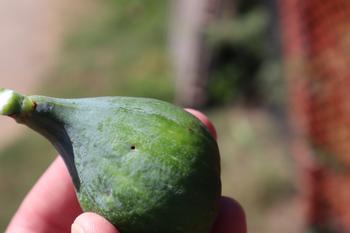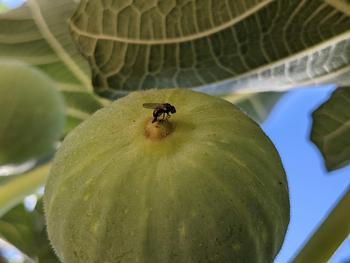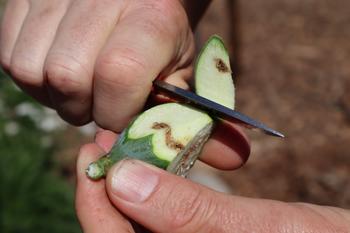Do you have a fig tree? Be on the lookout for the black fig fly.
-
Steven Swain, Environmental Horticulture Advisor, and Marin Master Gardener James Campbell
-
If you've got fig trees, listen up because there's a new troublemaker who's headed our way – the black fig fly (Silba adipata). Hailing all the way from the Mediterranean region, this little critter has become a real headache for fig enthusiasts in southern California, making itself at home in counties from San Diego to Ventura. It thrives in places with weather like ours, but fear not; we're here to help you navigate the buzz around this pest and keep your fig trees thriving.
 A small hole in the skin of a fig caused by a Black Fig Fly Photo: UC Regents
A small hole in the skin of a fig caused by a Black Fig Fly Photo: UC RegentsPicture this: you're eagerly awaiting the day when your figs are ripe for the picking, and suddenly, the black fig fly swoops in. This invasive troublemaker has a taste for figs. Females have a long ovipositor they use to lay eggs in the ostiole (the tiny hole at the bottom) of unripe or unpollinated figs. After the eggs hatch, the larvae chow down, leaving your figs damaged and downright inedible. For commercial growers, this means economic losses, and for us home gardeners, it's a surefire way to end up with a less-than-bountiful harvest. When they're full, the larvae drop down into the soil, where they pupate and later emerge as the next generation of adults.
Identifying this sneaky critter is key. Adult black fig flies are tiny – think 3.5 to 4.5 mm – with a dark brown to black glossy body, red eyes, brown legs, and some cool wing patterns. They're most active when the weather's warm, so keep your eyes peeled from late spring to early fall. When you're inspecting your fig trees, be on the lookout for puncture marks, small sunken areas on the fruit, or signs of premature ripening – these could be the black fig fly's calling cards. A Black Fig Fly laying eggs inside a green fig Photo: UC Regents
A Black Fig Fly laying eggs inside a green fig Photo: UC RegentsNow, what's a gardener to do if they spy signs of trouble? Don't panic – take action! Here are some down-to-earth steps for you:
- Keep an Eye Out: Regularly check your fig trees for any signs of black fig fly mischief. Early detection is the name of the game. These flies can have between four and six generations in our climate before they go dormant and overwinter.
- No hitch-hikers: Because this tiny fly pupates in the soil under fig trees, moving potted fig trees or transporting fruit from an infested area is a bad idea. Spreading this pest around doesn't help anyone.
- Close the door: We can keep these guys out of the fruit. Organza bags, like those used for party favors, can be used to cinch around young fruit. According to John Valenzuela of the California Rare Fruit Growers, little patches of masking tape over the ostiole can also effectively keep them away, and it's a whole lot cheaper.
- Clean Up the Act: Report any small figs with a small hole in the side that drop off the tree to your local Agricultural Commissioner at 415 473 6700 or the CDFA at 800 491 1899. They can confirm the infestation and help you make a management plan to minimize future losses.
 Damage inside a fig caused by the larva of the Black Fig Fly. Photo: UC Regents
Damage inside a fig caused by the larva of the Black Fig Fly. Photo: UC Regents - Trap 'Em: Ever thought about using sticky traps to snag those pesky flies? These traps are like a VIP party invite for the black fig fly, reducing the adult population and giving you a heads up on potential infestations.
- Be a Cultivator: Cultivate good habits, that is! Prune right, water adequately, and keep that orchard floor squeaky clean. Healthy, well-kept trees are like superheroes against pests.
Stay in the know, dear gardener! By staying on top of the black fig fly situation, you'll be the hero your fig trees deserve. Got questions or spotted these troublemakers? Reach out to your local UCCE Farm Advisor at 1682 Novato Boulevard, Suite 150-B Novato, CA 94947, or give them a ring at (415) 473-4204.



